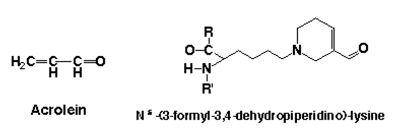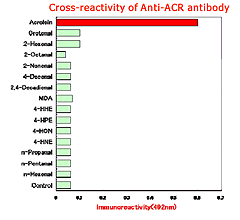 |
Oxidative Stress
Rev.081024 |
Anti Acrolein antibody
(Anti ACR monoclonal antibody: clone 5F6) |
|
|
Acrolein (ACR) is a representative
carcinogenic aldehyde found ubiquitously in the environment and formed endogenously through oxidation reactions, such as lipid peroxidation
and myeloperoxidasecatalyzed amino acid oxidation. ACR is highly reactive aldehyde and reacts with lysine residue in protein.
The reaction with ACR and lysine residue leads to the formation of numerous numbers of adducts, such as formyl-dehydropiperidino-lysine
(FDP-lysine) type derivative. This antibody is specific for the ACR-modified protein, especially FDP-lysine type derivative.
|
 |
|
| Specifications |
| Clone #: |
5F6 |
 |
| Antigen: |
ACR-modified keyhole-lympet hemocyanine |
| Form: |
Frozen (100 µg/mL antibody in 10mM PBS containing 0.1% NaN3 and 0.5% BSA).
Purified by Protein-A. |
| Application: |
Immunohistochemistry.
Recommended antibody concentration is 0.5-1.0 µg/mL on paraformaldehyde fixed tissue. |
| Specificity: |
Specific for ACR-modified protein (especially FDP-lysine type derivative) |
| Subclass: |
Mouse IgG1,kappa |
|
| References |
| 1) |
Protein-bound acrolein: Potential markers for oxidativestress.
K.Uchida, M.Kanematsu, K.Sakai, T.Matsuda, N.Hattori,Y.Mizuno, D.Suzuki,T.Miyata, N.Noguchi, E.Niki,T.Osawa
Proc.Natl.Acad.Sci.USA,95,4882-4887(1998) |
| 2) |
Protein-bound acrolein: A novel markers of oxidativestress in
Alzheimer's Disease. Noel Y. Calingasan, Koji Uchida, and Gary E.Gibson
Journal of Neurochemistry.72(2),751-756(1999) |
|
| Product name |
Code |
Content |
| Anti Acrolein monoclonal antibody |
MAR-020n |
20 µg of IgG |
| MAR-100n |
unavailable |
|
Manufactured by NOF corporation, Japan. |
| FOR RESEARCH USE ONLY. Not for diagnostic, medical or other use. |
| Procedure |
| 1) |
Paraffin sections were deparaffinized and rehydrated. |
| 2) |
Sections were quenched for several minutes with 3% hydrogen peroxide,
rinsed in PBS, pretreated for 30 min with 3% nonimmune animal serum in PBS. |
| 3) |
Sections were incubated overnight at 4°C with a antibody at a
dilution of 1 µg/mL. |
| 4) |
Antibody binding was visualized by the avidin-biotin-immuno
peroxidase complex method using the Vectastain ABC kit (Vector, Burlingame, CA) according to the manufacturer's instructions. |
| 5) |
3,3-Diaminobenzidine tetrahydrochloride was used as the chromogen. |
| 6) |
Hematoxylin or Eosin was used as the counter stain. |
|
| Technical Note |
| 1) |
Sections from which the primary antibodies were omitted served as
negative reaction controls. |
| 2) |
For frozen materials, samples were fixed in 10% formalin,
immersed in 30% sucrose in PBS, embedded at OCT (Sakura, Tokyo, Japan), and stored at 80°C. |
| 3) |
For paraffin embedded materials, samples were fixed in 10% formalin,
dehydrated, embedded in paraffin, and stored at room temperature. |
| 4) |
Microwave treatment improves the target staining, whereas it
declines non-specific background. |
| 5) |
Protease K treatment declines the target staining. |
|
| Positive control |
| |
Aortic wall in the renal tissue of diabetic nephropathy or
aortic wall of atherosclerosis. |
|
|
| FOR RESEARCH USE ONLY. Not for diagnostic, medical or other use. |
|